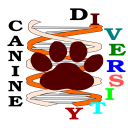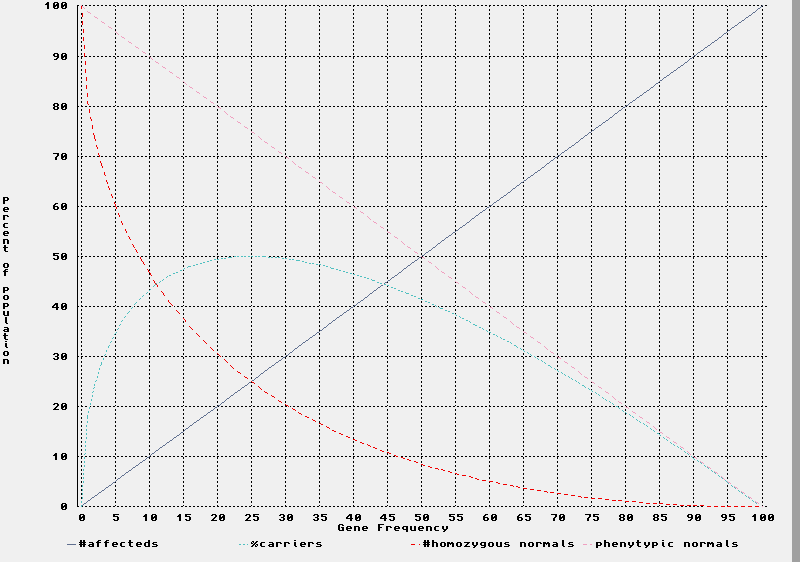
Essays on Dog Genetic Diversity
Inspired by conversations hosted by Jemima Harrison
The purpose of this website is to host essays and information about maintaining viable populations of healthy pure bred dogs

The purpose of this website is to host essays and information about maintaining viable populations of healthy pure bred dogs
In this essay fitness is used in the biological sense,"the capability of an individual of certain genotype to reproduce, and usually is equal to the proportion of the individual's genes in all the genes of the next generation". [ defintion from: Wikipedia entry on Fitness_(biology) ] not in the sense of athletic physical conditioning.
Promoting diversity will not "cure" the problem of exaggerated body form and selecting away from these extremes will not in itself promote biological vigor and fitness
If I breed an English Bulldog to a Pug and then cross the resulting offspring to a Pekingese I may have greatly increased diversity in relation to the MHC (Master Histocompatibility Complex) (the genetic complex that maintains vigor) but I will still have a flat-faced dog that has a deformed foreface, restricted nasal passages and can neither fully oxygenate its blood nor cool itself properly by panting and shedding heat through its lungs
Similarly if I breed a dysplastic Labrador to a dysplastic German Shepherd Dog I may have a allergy free crossbred with a great personality for obedience work, a but the chances are it will still be dysplastic and have limited athletic ability to work long hours as a search and rescue dog
I think it is important to distinguish between these two aspects of the problem of the health and well being of dogs: the need to preserve overall vigor and disease resistance on the one hand and the need to resist the human tendency to select for phenotypic exaggeration on the other hand.
Basically what natural selection does over rather long stretches of time as a successful lineage evolves is retain MHC diversity and fitness while selecting for physical and physiological traits that adapt the species to its way of life. In selecting for these characteristics little diversity is tolerated in those areas pushing towards physical specialization. We do not see coyote populations with normal stature individuals and short legged individuals. The short legged wild canid - The Columbia Bush Dog - is adapted to a different way of life than being a high speed courser like the coyote.
We do not have modern horses in which there is a mixture of tooth form ranging from the low crowned rounded teeth of Hyracotherium (a dog sized ancestral horse previously called Eohippus) to the 5 inch long high crowned teeth of the modern horse
Natural species may even loose physiological capabilities when it seems "unnecessary" some leaf and fruit eating mammals such as humans, fruit bats and guinea pigs have lost the ability to manufacture vitamin C, something that is retained in members of the Carnivora, including dogs. Sometimes loosing a useful trait has long term consequences, the reptiles ancestral to modern mammals - small nocturnal animals - lost the excellent full color vision seen in reptiles. Only a few mammalian lineages have re-evolved color vision.
The Concept of Archetype and its effect on our actions
The image of the evolving and specializing natural species may in part underlie the pure bred dog breeder's image of "perfecting the breed". The perfection of a breed implies an image to aim for of the perfect animal. This brings to mind the Greek philosophical concept of the "archetype", the abstract, idealized form. Real world representations of the archetype being but imperfect shadows
Even in biology when we describe a species we are also dealing with this concept of a archetype. A biologist naming a new species will choose an individual (or individuals) to be the "type specimen" for the species and it will be preserved in a museum collection in a special space usually called the "Type Room" and access to this room is restricted in all the museums I have worked in (Museums also restrict access to the "fur vault" and the gem collection, but for different reasons). Then the biologist writes up and publishes a detailed description of the type specimen(s) and later researchers consult this description to see if the animal or plant they have at hand is a member of the same species. In the last 40+ years genetic information has also been used as a part of species definitions but mostly it is still the phenotypic description (plus habitat considerations now) that underlies it all
I have had serious discussions with biologists who are also dog breeders who seem to think of their dog breed as a species or subspecies and who have a great deal of resistance to the idea of interbreed crosses because they feel it will reduce the adaptations of their dogs to the purpose for which they are bred. These people get pretty emotional about the pollution of, for example, the "pure" East Transylvanian Bat-hound by out crossing it with the obviously mongrelized Lowland Transylvanian Bat-hound simply because you only have 12 of the former as founders in your entire registry and you would like to add genes from the larger population of the latter to increase disease resistance
In contrast field biologists are discovering that even species may hybridize in the wild when changing ecological conditions promote it. The current "red wolf" and also the large coyotes now seen in eastern North America may well be an ongoing example of this.
Natural selection does not have rules about species purity, just on being well adapted and vigorous and having grandchildren. Interfere with vigor and you lose, interfere with needed adaptation and you lose, fail to have grandchildren and you lose. Of course 99% of the species that we know of in the fossil record are extinct without descent so losing seems to be the norm and survival in the long run, the exception
This DOES mean however, that the components of the genetic system that program for disease resistance and vigor are retained in evolving populations, even though the population structure of many species seems to be that of a series of small local groups with occasional gene exchange to neighboring groups. Biologists are just starting to work out how this has happened
One thing that has been discovered is that some mammalian pheromones transmit information about the genetic composition of the MHC complex and prospective mates are attracted to individuals with an MHC complex that is different from their own. But in domestic mammals, human managed breeding situations prevent this mechanism from acting to preserve MHC complex diversity
Another thing that occurred to me is this (and I am sure some well known worker in the field has already noticed): If MHC heterozygosity gives increased vigor and fitness, then the heterozygotes in a wild population will be the individuals that have greater reproductive success over the long haul
If we look at the Hardy Weinberg equilibrium equation x^2 + 2xy +y^2, and the two homozygotes are selected against, then even in rather small populations (say 100 breeding individuals) selection is acting to retain heterozygosity in the gene series in which heterozygosity promotes fitness

| A Plot of the Hardy-Weiberg Equilibrium Equation | ||
|---|---|---|
| ---- | solid grey line: | % affecteds |
| ---- | dashed cyan line: | % carriers |
| ---- | dashed red line: | % homozygous normals |
| ---- | dashed pink line: | % phenotypic normals |
The dashed pink line is the percentage of normal appearing individuals. The solid dark line is the percentage of affected individuals. The dashed red line is the percentage of individuals homozygous for the dominant normal gene((Homozygous: having two copies of a gene)). The dashed blue lin is the percentage of individuals who are homozygous for the recessive gene
---- So I the problem of breeding healthy dogs suited to the work((anything from being excellent pets and companions to hunting, guarding and our other tasks for our dogs)) that we wish them to do becomes a two fold problem: (1) how to retain the diversity important to biological fitness and vigor
(2) How to actually select for phenotypic traits that adapt the dog to its work while avoiding the selection for phenotypic traits that harm the dog and how this impacts the important work of selecting for biological fitness.
I know of one instance in a relatively rare breed of sighthound where one of the kennels, owned by two biologists, practices "mate choice" in an attempt to let the dogs match themselves up with mates whose MHC genes are as different as possible. This is a very promising strategy
As our understanding of how wild populations maintain their vigor other solutions may also become appatent
However we need also to keep in mind that dogs should not be bred for physical extremes that interfer with normal life or function. A better understanding of biomechanics is needed. It is important to realize that fucntion molds form and function is evaluated by watching the performance of the animal at work, not by trying to imagine it from observation of an animal in a static situation removed from the work
If we really could predict function from an examination of the animal at rest then knowledgable people would be extremely successful betting on races and handicappers would not have to consult tables of past performances of the contestants.
Pedigree Dogs Exposed - The Blog
A Bitter Cynoanarchist Rages On
Online Mendelian Inheritance in Animals (OMIA) OMIA
Understanding Gene Loss in successive generations An Interactive Academic Site on "Gene Dropping" at University of Montana
GENUPComputer aided learning for quantitative genetics.
Although a Windows application Bonnie Dalzell has been able to run it under Ubuntu Linux from my desktop.
A tactical approach to the design of crossbreeding programs.
Cultivar Crazy - Preserving the Genetic Heritage of Plants
Applied Animal and Plant Breeding
The Effects of Genetic Drift, Inbreeding, and Interpopulation Hybridization experimental study involving Drosophila (fruit flies)
Inherited Diseases in Dogs (IDID)
Canine Inherited Disorders Database
List of Inherited Disorders in Animals (LIDA)
VMDB Veterinary Medical Database
The Veterinary Medical Database (VMDB) compiles patient encounter data from nearly all North American veterinary medical databases.
CERFCanine Eye Registration Foundation
CHIC) Canine Health Information Center
OFAOrthopedic Foundation for Animals
CERF Canine Eye Registration Foundation
A Healthier Future for Pedigree Dogs
Closed Registries, Genetics, and Inbreeding Depression
A series of articles concerning the genetics of selection, inbreeding, inheritance of congenital defects.
All 4 essays by Susan Thorpe-Vargas Ph.D., John Cargill MA, MBA, MS, and D. Caroline Coile, Ph.D
Project to breed Dalmations with normal uric acid metabolism
Clarmorris Parson Russell Terriers
The Effects of Genetic Drift, Inbreeding, and Interpopulation Hybridization experimental study involving Drosophila (fruit flies)